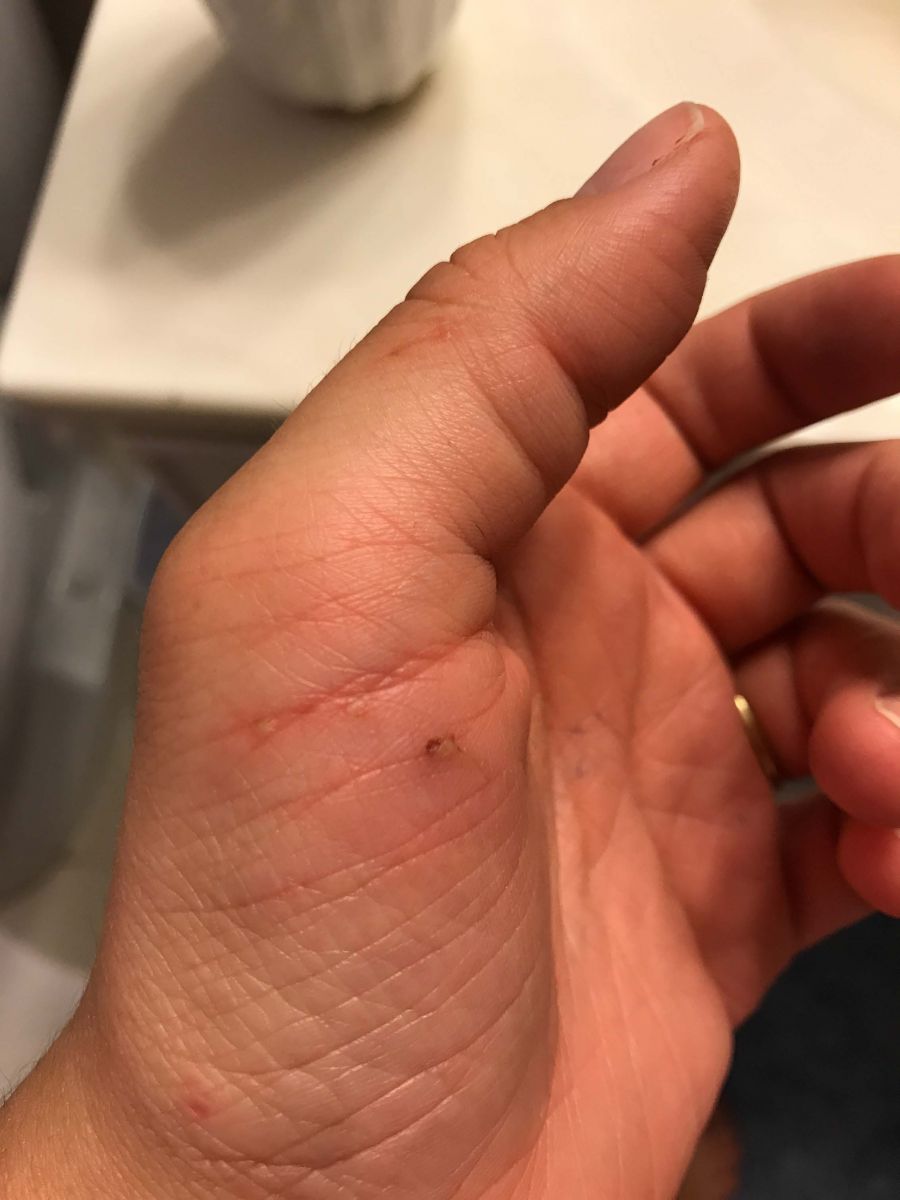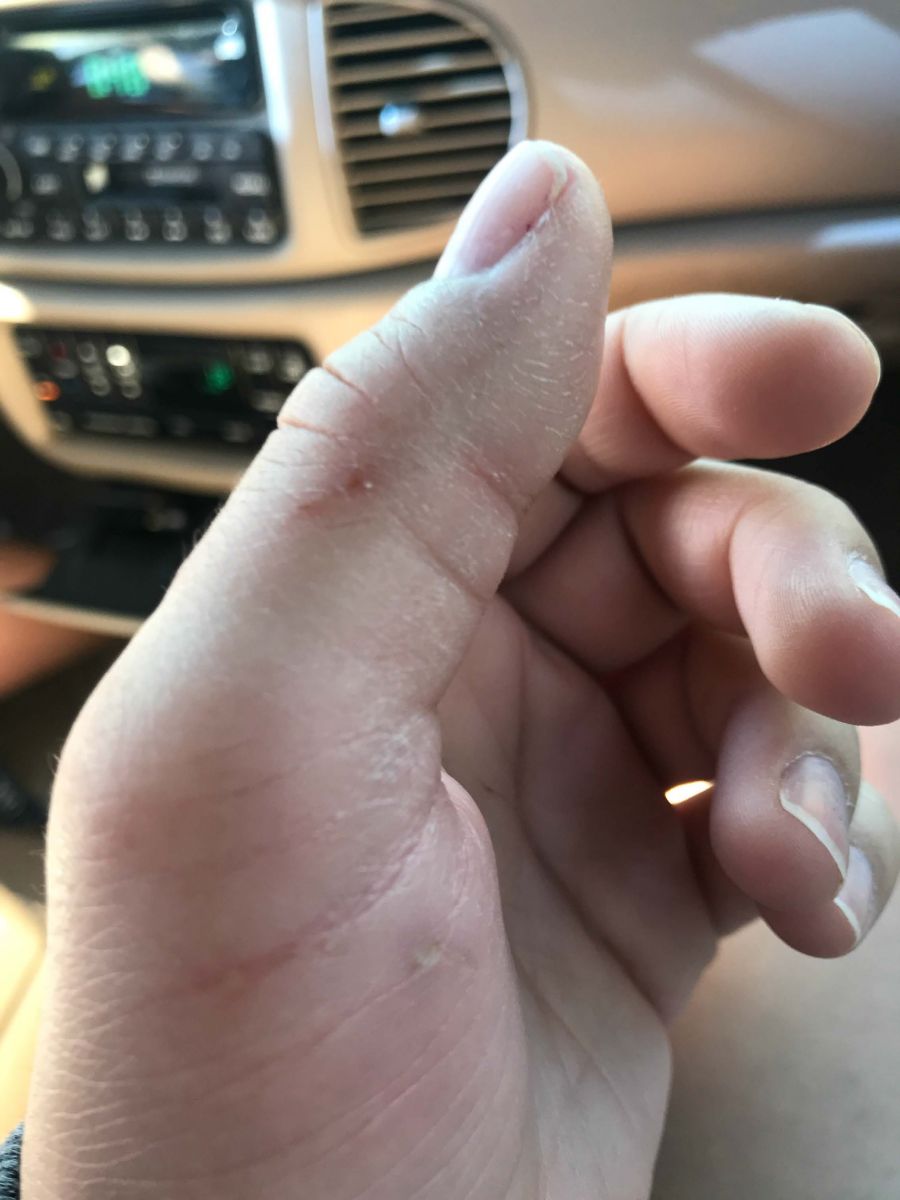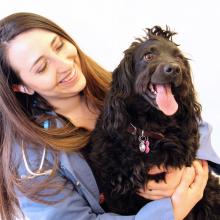As a veterinary student, I have felt a strong connection with animals for most of life. This connection is one of the reasons I chose a career in veterinary medicine. I pride myself on being able to read animal behaviour, and understand what an animal might be trying to communicate, however my interpretations are not always right.
About one week into my externship, I can feel a bit of confidence building. I’m starting to ask the right questions to clients; I’m starting to feel better about making differential diagnosis; and I’m starting to feel like my animal handling is improving. That’s when it happens. While doing a physical exam, a cat chomps down on my left thumb, piercing the skin and drawing blood. Surprisingly I kept my composure, pried the cat off my hand, and explained to the owner we might have to sedate this poor scared cat for its exam. Yet in the back of my mind, I’m starting to piece together the future consequences of this small bite.
Animal Behaviour
Unfortunately, the animals that veterinarians love, are also one of the largest the sources of work place injuries. Getting injured by an animal is a risk that veterinarians and technicians are aware of when they enter into the profession. Whether it is a bite, scratch, or a kick; animal professionals are aware of the different ways an animal can injure them, and many have experienced these injuries. I personally have been kicked by many cattle, bitten by dogs, and scratched by cats; however, I have never once looked back on the career I have chosen, nor blamed the animal for their actions.

| Click here to see the poster “How to handle patients in a caring manner and what to avoid.” Empathy leads to compassionate care. Cattledog Publishing www.drsophiayin.com |
You see, animals have very limited ways to communicate with humans. They have no words to tell us when they are sick or hurt, only their behavior can give us a hint of what they are feeling.
Sometimes a sick dog is simply quieter than usual, or perhaps more vocal. Sometimes the cat with a broken leg can only tell us it hurts by behaving more aggressively. Sometimes the only way a horse can tell us that they feel uncomfortable is with a good hard kick. It is not that they mean it to be harmful, but it is their only way to communicate.
At my school, Ontario Veterinary College, throughout the years, they teach you the different behaviour patterns that animals demonstrate and proper handling techniques. There are charts for painful behaviour patterns for different species. There are charts that demonstrate fear, aggression, sickness, happiness, etc… that it truly becomes its own language, and with any language, the more you practice the better you become.
In the end, the day I was bitten it was my own fault, not the cats. I didn’t properly read the cat’s behaviour, and biting me was the only way she could communicate how she was feeling. It is a risk that comes with the job, and it provided me a learning experience for the future. Next time, I will be more observant with my patient and practice safer handling skills. You would hope that this would be the end of the story. I got bitten, I learned my lesson, and hopefully I won’t be bitten again anytime in the near future. However, there’s one small problem with that story, and it’s a problem that most people would likely not think about… I got bit by a cat.
Never Underestimate a Cat Bite
Now I’m sure most people reading this are a bit confused by that statement. I have been kicked, scratched and bitten in the past. What is the big deal about being bit by a cat? As cute and cuddly as our sweet kitty cats may look, they harbour a whole lot of nasty bacteria in their mouth. Being bitten by a cat, is kind of like being stabbed by a needle; their teeth are very small, and they can introduce bacteria into your skin. One of the most common bacteria in a cat’s mouth is a highly pathogenic bacteria, called Pasteurella multocida. This nasty bacteria causes cellulitis (an infection) in the skin within 24 hours, however normally it takes 48 to 72 hours to develop. The first signs people normally see are swelling and redness, and if left untreated it can lead to septicaemia (blood poisoning).
 This is exactly what happened in my case. Initially after the bite, I washed it thoroughly, and took an Advil, to prevent swelling. The bite was painful, but not unbearable, and it did not swell. The first photo on the right is my hand right after the cat bite. It doesn’t look like much does it?
This is exactly what happened in my case. Initially after the bite, I washed it thoroughly, and took an Advil, to prevent swelling. The bite was painful, but not unbearable, and it did not swell. The first photo on the right is my hand right after the cat bite. It doesn’t look like much does it?
 However, the next morning when I woke up, my thumb was extremely swollen, and I could barely move it. My finger looked like a sausage. The pain associated with it was quite excruciating, and I could barely brush it on anything without wincing in pain and getting tears in my eyes. The second picture is what my hand looked like that morning.
However, the next morning when I woke up, my thumb was extremely swollen, and I could barely move it. My finger looked like a sausage. The pain associated with it was quite excruciating, and I could barely brush it on anything without wincing in pain and getting tears in my eyes. The second picture is what my hand looked like that morning.
 Taking the advice of my co-workers and knowing about the pathogens that cats carry in their mouth, I knew that cat bites were not something I should “play around with.” I immediately booked it to the emerg, and within an hour, I was on IV antibiotics. I was prescribed three more days of IV antibiotics, and then another seven days of oral antibiotics after that. The hospital staff informed me that this is their typical routine with cat bites, and that I was smart not to wait too long to get treated. Apparently many people don’t realize the severity of cat bites, and this can sometimes lead to surgery, nerve damage, or blood poisoning. I’m currently on my last day of IV antibiotics, about to start my oral antibiotics, however the swelling and pain are not fully gone.
Taking the advice of my co-workers and knowing about the pathogens that cats carry in their mouth, I knew that cat bites were not something I should “play around with.” I immediately booked it to the emerg, and within an hour, I was on IV antibiotics. I was prescribed three more days of IV antibiotics, and then another seven days of oral antibiotics after that. The hospital staff informed me that this is their typical routine with cat bites, and that I was smart not to wait too long to get treated. Apparently many people don’t realize the severity of cat bites, and this can sometimes lead to surgery, nerve damage, or blood poisoning. I’m currently on my last day of IV antibiotics, about to start my oral antibiotics, however the swelling and pain are not fully gone.
So what should you do if you get bitten by a furry friend? No matter if it’s a dog, cat or any other furry friend, the first thing you should do is wash the wound under running water with soap. Try to avoid scrubbing too vigorously or using strong disinfectants, because this can harm the tissue around the wound and delay healing. Control any type of bleeding with pressure, or absorbent dressings/bandages. Most importantly, go see your physician as soon as possible. Even if you have no symptoms, or the bite may be small, the bacteria introduced into the skin can act quickly, and a serious infection can develop within 24 to 48 hours.
Lastly, on top of pesky bacteria, another important risk that comes with an animal bite is exposure to rabies. Luckily many of our household friends are vaccinated against rabies, however unless you can confirm the animal has been vaccinated, you should never assume there is no risk. Rabies is a very serious zoonotic virus that is transmitted by saliva, usually by a bite. This virus affects the brain and nervous system of animals and humans, and if it is not treated before symptoms appear, it is almost 100 per cent fatal.
Bites from an animal should be reported immediately to Public Health so that they can investigate the risk of rabies exposure. You should also immediately see a doctor as stated above. Typically, the animal will be placed in isolation for 10 days, to see if symptoms of rabies develop. If the animal is up to date on their vaccine against the virus, there is less of a concern of exposure. However if the animal is not vaccinated, it’s very important to place the animal in isolation. If the symptoms develop within 10 days, the person that was bitten is contacted and immediately started on rabies preventatives. There are two types of preventatives used in cases of rabies, the first is one dose of rabies immune globulin that will help neutralize the virus before it becomes established; and the second is four doses of rabies vaccine give over 14 days to help the immune system make antibodies against the virus. This treatment can only be conducted before symptoms appear, if symptoms are already observed, death is almost certain.
Luckily I am already vaccinated against rabies, and I get my antibody levels (known as a titre) checked yearly. My most recent titre revealed that my antibody levels are still very high, therefore my risk is minimal. The cat that bit me still underwent a 10-day quarantine, because of standard procedure. If the animal did turn out to have rabies like symptoms, I’d likely get a booster vaccine to ensure my antibody levels were sufficient. Otherwise, if no symptoms appear, the quarantine will end, and the cat can go back to carrying out its usual routine.
So overall, as you can see, a simple small cat bite, caused by my own miscommunication with an animal, can lead to quite an extensive path. I have learned not to underestimate a creature much smaller than myself and to act quickly when it comes to my health, and I hope the rest of you have learned from my mistake to never, ever, underestimate a cat bite.
Resources:
http://www.bccdc.ca/health-info/diseases-conditions/rabies
https://www.merckvetmanual.com/dog-owners/brain,-spinal-cord,-and-nerve-disorders-of-dogs/rabies-in-dogs
https://vcahospitals.com/know-your-pet/wounds-cat-bite-injuries-to-humans
